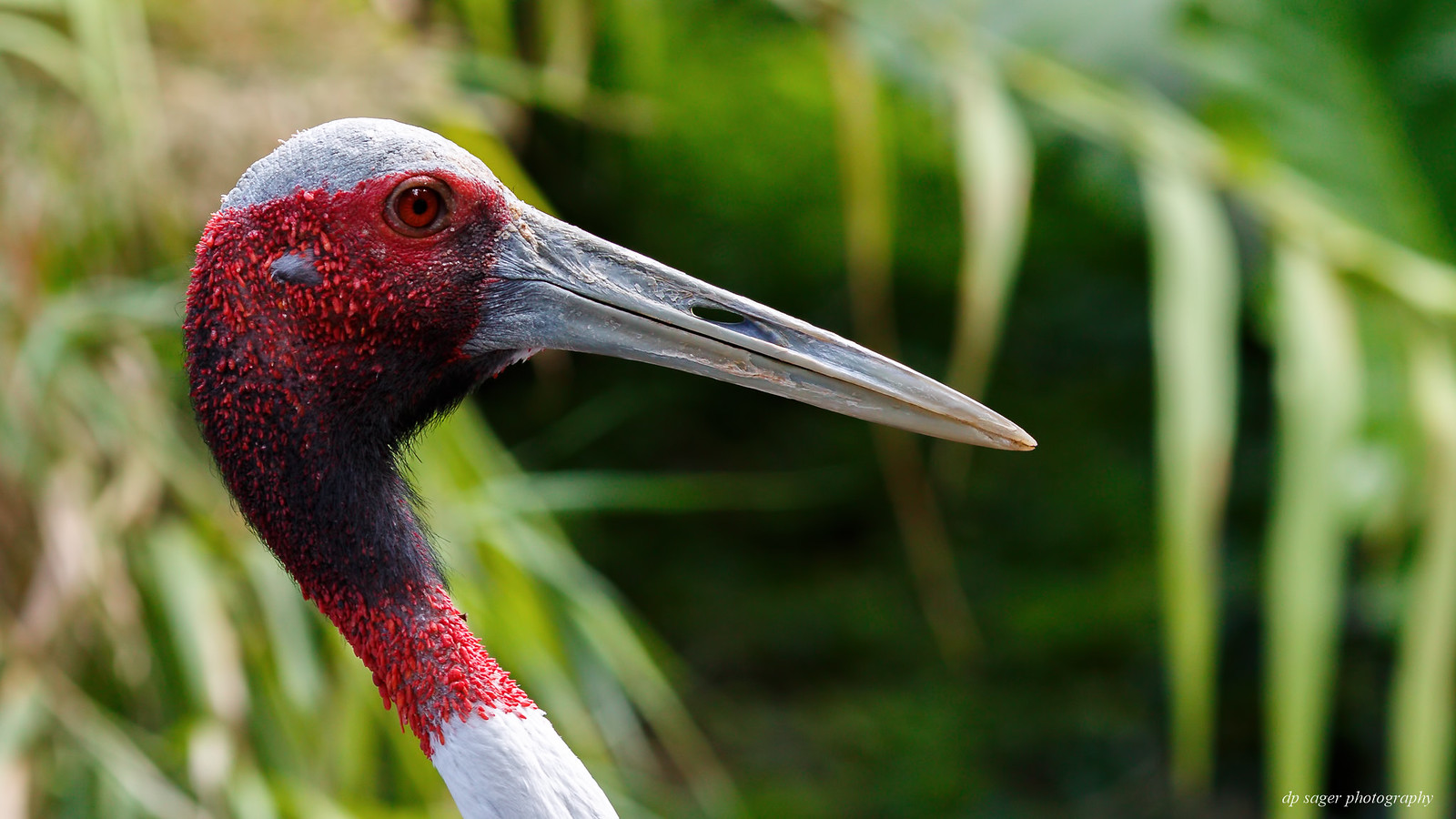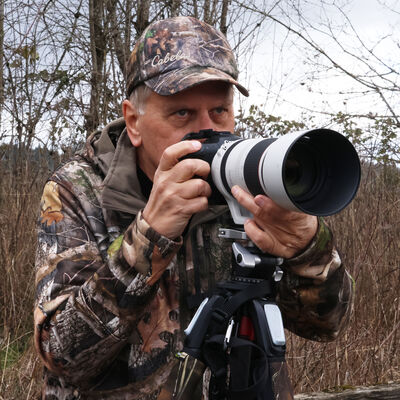The EF Extender 1.4III revisited
Apr 9, 2024 08:51:12 #
Over the years, you may remember some posts about Canon Extenders, certain Canon L-series EF lenses, and the series III Canon EF Extenders 1.4 and EF 2.0. Both these lens focal length "extender" tools are standard equipment in my kit bag. The example images in the post provide some updated examples through early 2024.
Sarus Crane by Paul Sager, on Flickr

This discussion of Canon L-series lenses uses just the Canon Series III 1.4x extender. Yes, I recognize the 'agedness' of this topic, a discussion of SLR / DSLR technology in 2024, now a few years into the mirrorless revolution.
Meerkat

Lens extenders are sometimes known as "teleconverters" by other lens brands.
African Wild Dog

The EF 135mm f/2L USM is a Canon classic lens, renowned for its image sharpness, fast and accurate autofocus, and extremely wide f/2 aperture. When paired with the 1.4x extender, the lens yields an effective 189mm f/2.8 configuration.
Military Macaw

In general, a wide-aperture lens enables the higher sensitivity AF points. The f/2 aperture and the extended f/2.8 aperture provide significant light for fast and accurate focusing. The 8-blade aperture of the 135L helps keep OOF (Out of Focus) highlights round and smooth.
Fort Matanzas National Monument on film

The Canon EF 135mm f/2L USM Lens was introduced in 1995. The lens is excellent for indoor low light situations, such as sports and the zoo examples shown in this post. When connected with the 2x extender, the combination create a 270mm f/4, although a configuration I have not used.
US Navy Blue Angels

The 40% bump in focal length provided by the 1.4x extender might be considered negligible where cropping from a high-resolution image, instead of carrying another piece of equipment, might be more efficient. The loss of 1-stop of light might also offset the benefit of the added focal length. The native 135mm, and the extended 189mm, are both covered by a 70-200 zoom, although all versions of these Canon zoom lenses are larger and heavier than the 135L prime. The f/2.8 Canon zooms, with and without IS, are also more expensive.
Sunbittern

The Canon EF 100-400mm f/4.5-5.6 IS II USM and the EF 1.4x III Extender creates a 560mm focal length combination at the maximum zoom length. Many zoom lenses, third-party and Canon, lose a touch of sharpness at their maximum focal length. That is not the case with the 100-400L II. When the 1.4x extender is used, the resulting zoom range is 140mm to 560mm.
Cicada

The Series II 100-400L features Canon's latest Image Stabilizer system, allowing users to shoot at speeds up to four times slower than normally required. Canon's IS-enabled lenses in Series II (& III) feature three IS modes. Mode 1 is the normal mode, used for typical photography, where the subject does not move. Mode 2 is used for panning; this is useful for sports or wildlife photography, where the subject moves constantly and one will need to pan. Mode 3, intended to track action, is similar to Mode 2 in that it ignores panning; however, it applies stabilization only when the shutter is released, the viewfinder image is not stabilized.
Coneflower

The Series II model of the EF 100-400L features a dramatically shortened MFD (Minimum Focus Distance) and a significantly-increased MM (Maximum Magnification) effect. The 100-400 II can focus on subjects just 38.4-inches (980mm) from the camera sensor. This distance is nearly half the MFD of the old lens. The Series II can produce subject details 50% larger than the previous lens.
Monarch

Adding the 1.4x extender creates a 140-560mm zoom lens. All the images in this post were captured using a Series III 1.4x extender at the maximum 560mm zoom length. The primary impact of using the 1.4x extender is the reduction in maximum aperture. With the 1.4x mounted behind the 100-400, the max aperture range narrows to f/6.3 - f/8 on this variable aperture lens.
Four legged tadpole

Sarus Crane by Paul Sager, on Flickr

This discussion of Canon L-series lenses uses just the Canon Series III 1.4x extender. Yes, I recognize the 'agedness' of this topic, a discussion of SLR / DSLR technology in 2024, now a few years into the mirrorless revolution.

Meerkat

Lens extenders are sometimes known as "teleconverters" by other lens brands.
African Wild Dog

The EF 135mm f/2L USM is a Canon classic lens, renowned for its image sharpness, fast and accurate autofocus, and extremely wide f/2 aperture. When paired with the 1.4x extender, the lens yields an effective 189mm f/2.8 configuration.
Military Macaw

In general, a wide-aperture lens enables the higher sensitivity AF points. The f/2 aperture and the extended f/2.8 aperture provide significant light for fast and accurate focusing. The 8-blade aperture of the 135L helps keep OOF (Out of Focus) highlights round and smooth.
Fort Matanzas National Monument on film

The Canon EF 135mm f/2L USM Lens was introduced in 1995. The lens is excellent for indoor low light situations, such as sports and the zoo examples shown in this post. When connected with the 2x extender, the combination create a 270mm f/4, although a configuration I have not used.
US Navy Blue Angels

The 40% bump in focal length provided by the 1.4x extender might be considered negligible where cropping from a high-resolution image, instead of carrying another piece of equipment, might be more efficient. The loss of 1-stop of light might also offset the benefit of the added focal length. The native 135mm, and the extended 189mm, are both covered by a 70-200 zoom, although all versions of these Canon zoom lenses are larger and heavier than the 135L prime. The f/2.8 Canon zooms, with and without IS, are also more expensive.
Sunbittern

The Canon EF 100-400mm f/4.5-5.6 IS II USM and the EF 1.4x III Extender creates a 560mm focal length combination at the maximum zoom length. Many zoom lenses, third-party and Canon, lose a touch of sharpness at their maximum focal length. That is not the case with the 100-400L II. When the 1.4x extender is used, the resulting zoom range is 140mm to 560mm.
Cicada

The Series II 100-400L features Canon's latest Image Stabilizer system, allowing users to shoot at speeds up to four times slower than normally required. Canon's IS-enabled lenses in Series II (& III) feature three IS modes. Mode 1 is the normal mode, used for typical photography, where the subject does not move. Mode 2 is used for panning; this is useful for sports or wildlife photography, where the subject moves constantly and one will need to pan. Mode 3, intended to track action, is similar to Mode 2 in that it ignores panning; however, it applies stabilization only when the shutter is released, the viewfinder image is not stabilized.
Coneflower

The Series II model of the EF 100-400L features a dramatically shortened MFD (Minimum Focus Distance) and a significantly-increased MM (Maximum Magnification) effect. The 100-400 II can focus on subjects just 38.4-inches (980mm) from the camera sensor. This distance is nearly half the MFD of the old lens. The Series II can produce subject details 50% larger than the previous lens.
Monarch

Adding the 1.4x extender creates a 140-560mm zoom lens. All the images in this post were captured using a Series III 1.4x extender at the maximum 560mm zoom length. The primary impact of using the 1.4x extender is the reduction in maximum aperture. With the 1.4x mounted behind the 100-400, the max aperture range narrows to f/6.3 - f/8 on this variable aperture lens.
Four legged tadpole

Apr 9, 2024 09:21:48 #
Apr 9, 2024 10:11:25 #
Apr 9, 2024 10:43:23 #
Very nice, Paul. When using the 100-400 ii with my R5, the 1.4x iii is always close by. The lens and tc are a marriage made in heaven (should there be such a place). It has never occurred to me that the tc might do well in concert with other lenses. It just may be time to try…. Thank you….
Apr 9, 2024 12:48:48 #
47greyfox wrote:
Very nice, Paul. When using the 100-400 ii with my R5, the 1.4x iii is always close by. The lens and tc are a marriage made in heaven (should there be such a place). It has never occurred to me that the tc might do well in concert with other lenses. It just may be time to try…. Thank you….
One of the things about extenders that never seems to be discussed is that the close focusing capabilities of a lens is preserved when using an extender. If the close focus of a lens without extender is 6' it will also be 6' with extender.
Apr 9, 2024 12:52:52 #
An excellent review by Paul ........but I would like to expand on it just a bit
The version II extenders are now 1/2 the price of the version III's in the used market - so many wonder, what is the difference ! ? The 1.4 V-II is 5 elements and the V-III is 7 elements. The 2X V-II is 7 elements and the V-III is 9 elements - so for both you gain 2 elements. The V-III's also have "better" coatings. For most lenses, this results in slightly better resolution in the outer 1/3 of coverage area towards the corners of full frame. According to Canon, the electronic algorithms in the V-III's give enhanced AF performance - but only with VII lenses. The overall advantage of V-III extenders - especially with older non- V-II lenses is therefore very minimal - if any - especially if you are using a crop frame camera. How do I know this ? I have an early and late version of Canon's "Lens Work" books that show the the MTF graphs of all their lenses with the extenders.
.
The version II extenders are now 1/2 the price of the version III's in the used market - so many wonder, what is the difference ! ? The 1.4 V-II is 5 elements and the V-III is 7 elements. The 2X V-II is 7 elements and the V-III is 9 elements - so for both you gain 2 elements. The V-III's also have "better" coatings. For most lenses, this results in slightly better resolution in the outer 1/3 of coverage area towards the corners of full frame. According to Canon, the electronic algorithms in the V-III's give enhanced AF performance - but only with VII lenses. The overall advantage of V-III extenders - especially with older non- V-II lenses is therefore very minimal - if any - especially if you are using a crop frame camera. How do I know this ? I have an early and late version of Canon's "Lens Work" books that show the the MTF graphs of all their lenses with the extenders.
.
Apr 9, 2024 12:59:56 #
Apr 9, 2024 13:24:20 #
A great set of images, Paul.
I sold and traded most of my EF lenses for RF glass, including the EF 1.4x III, after moving to the R5 + R7 mirrorless bodies. Well, a couple of years later I discovered that I just might be able to afford a lens that I didn't think I'd ever be able to own. I purchased a used EF 500mm f/4 II big white lens at less than half the original cost. Of course, I had to repurchase a used 1.4x III extender to go with it. I think I paid a little less than what I originally sold mine for, so I wasn't too angry with myself. The extender rarely leaves the 500mm. It's a big beast, but 500mm at f/4 or 700mm at f/5.6 with extreme sharpness. They make a great combination paired with the excellent RF 100-500mm zoom which is a very close focusing lens.
I sold and traded most of my EF lenses for RF glass, including the EF 1.4x III, after moving to the R5 + R7 mirrorless bodies. Well, a couple of years later I discovered that I just might be able to afford a lens that I didn't think I'd ever be able to own. I purchased a used EF 500mm f/4 II big white lens at less than half the original cost. Of course, I had to repurchase a used 1.4x III extender to go with it. I think I paid a little less than what I originally sold mine for, so I wasn't too angry with myself. The extender rarely leaves the 500mm. It's a big beast, but 500mm at f/4 or 700mm at f/5.6 with extreme sharpness. They make a great combination paired with the excellent RF 100-500mm zoom which is a very close focusing lens.
Apr 10, 2024 08:35:42 #
Apr 10, 2024 08:54:26 #
Apr 10, 2024 10:22:09 #
CHG_CANON wrote:
Over the years, you may remember some posts about ... (show quote)
Excellent series and narrative Paul!
Apr 10, 2024 12:29:07 #
Apr 10, 2024 12:32:39 #
Apr 10, 2024 19:02:43 #
I use my Nikon TC III 1.4 frequently.
My favorites are #1 through #4 and #9.
Detail, sharpness, light, background
My favorites are #1 through #4 and #9.
Detail, sharpness, light, background

Apr 12, 2024 09:53:28 #
Thank you jimvanells, Alvin, 47greyfox, rcarol, Larry, Mike, MtManMD, mvetrano2, Joe, junglejim1949, Bruce, Earnest, Jeff! There's always the reality of losing a bit of image quality with an extender. I've come to the position of skipping the extender if I can, either because I don't need it or I have a native lens focal length for the distance. But otherwise, I'll take the longer effective focal length over not having enough pixels from cropping.
If you want to reply, then register here. Registration is free and your account is created instantly, so you can post right away.









